News
How Has the World Changed in the Last 20 Years?
- 07 April 2014
News
UNITED NATIONS, New York – Twenty years ago, the international community gathered in Cairo, Egypt, to explore how the world was changing and how those changes were affecting the most vulnerable. At the 1994 meeting, the International Conference on Population and Development (ICPD), the world agreed that population issues – including voluntary family planning, maternal and child health, migration, and gender equality – are not just about counting people, but about making sure that every person counts.
At the conference, 179 governments signed on to the ICPD Programme of Action, which recognizes that women, their rights and equality are global development priorities. The governments committed to: providing universal access to voluntary family planning, sexual and reproductive health services and rights; delivering gender equality and equal access to education; addressing the impacts of urbanization and migration; and supporting sustainable development.
Today, the world is very different, transformed by the digital revolution and advances in medicine and human knowledge. But has it changed in the ways we hoped it would?
Below, UNFPA reflects on some of the biggest ways our world is different, and what more must be done.
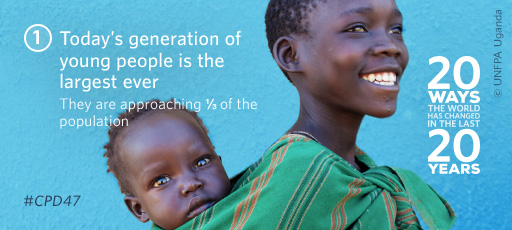
1. The world now has the largest generation of young people ever.
Adolescents and youth, those between 10 and 24 years old, accounted for 28 per cent of the world population in 2010. The world must invest in the needs and rights of this group, supporting their access to quality health care and education, opportunities for safe paid work, and freedom from abuses such as early marriage and pregnancy.1
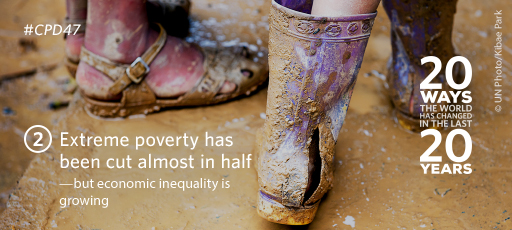
2. The proportion of people living in extreme poverty has been cut nearly in half – but economic inequality is now growing.
The proportion of people living on less than $1.25 per day has fallen from 47 per cent in 1990 to 22 per cent in 2010. But growing inequality could undermine these gains.
Today, 8 per cent of the world population has 82 per cent of global wealth, and more than a billion people continue to live in extreme poverty, without access to social protections, meaningful work, or public health or education services. The gains made over the past 20 years cannot be sustained if we do not address inequality.1,2
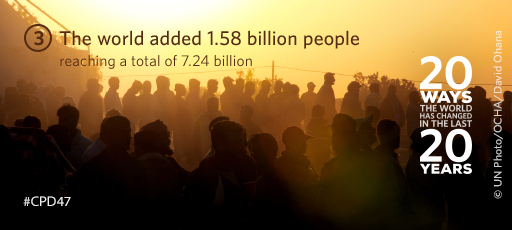
3. In the last 20 years, the world’s population grew by about a quarter, from 5.66 billion to 7.24 billion.
Every one of the world’s 7.2 billion people – and every person still to come – deserves to have their human rights and dignity respected and protected. This includes ensuring the equal rights of women and universal access to sexual and reproductive health and rights.3
4. But the population is growing more slowly.
Twenty years ago, the population was growing by 1.52 per cent per year. Today, it is growing by 1.15 per cent per year. On its current trajectory, we can expect the global population to reach 9.55 billion by 2050.1,3 Population growth has slowed because…
5. Women are having fewer children.
In 1994, the average woman had about three children. Today, the fertility rate is around 2.5 children per woman. Lower fertility means improved outcomes for women, since pregnancy is accompanied by risks that multiply a woman’s chance of dying.
But fertility rates remain high in some of the poorest places in the world. In 18 countries, fertility rates stand at five children or more per woman.1,3
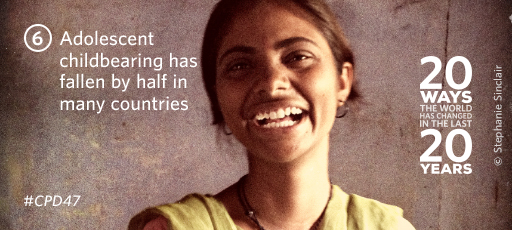
6. Adolescent childbearing has fallen by 50 per cent or more in many countries.
Adolescent fertility rates have fallen. Still, 20,000 girls under age 18 give birth in developing countries every day. And every year, there are 70,000 adolescent deaths from complications of pregnancy and childbirth.3,4
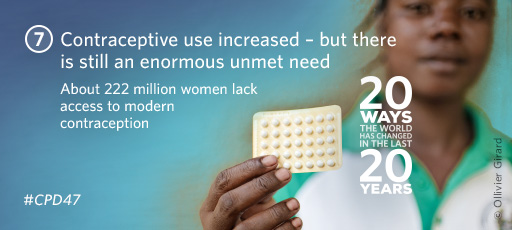
7. Contraceptive use has increased in the last two decades – but there remains a huge unmet need.
Most women say they want between two and four children. Safe, modern contraceptives and family planning services help women achieve these goals by preventing unwanted pregnancies.
But between 2008 and 2012, the proportion of married women in the developing world using modern contraceptives only changed from 56 per cent to 57 per cent. There are about 222 million women without access to modern contraception.5,6,7
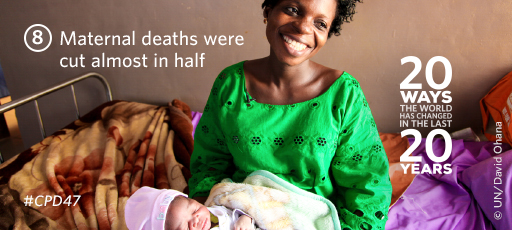
8. Maternal deaths have fallen by almost half.
Deaths related to complications in pregnancy and childbirth have dropped by 47 per cent since 1994. Back then, more than half a million maternal deaths occurred each year.
But more must be done. Today, 800 maternal deaths occur every day, and the leading causes – post-partum haemorrhage, sepsis, obstructed labour, complications from unsafe abortion, and hypertensive disorders – are all preventable.1,3
9. Child deaths fell by nearly half.
Deaths among children under age five fell from 90 per 1,000 live births in 1990 to 48 per 1,000 live births in 2012. A major factor contributing to this decline is increased education for women and girls. When women and girls are educated, they are empowered to make better choices for themselves and their families. Girls’ education is linked to lower rates of child marriage, lower rates of adolescent pregnancy, and increased access to maternal and child health care, all of which improves child survival.1,7,8
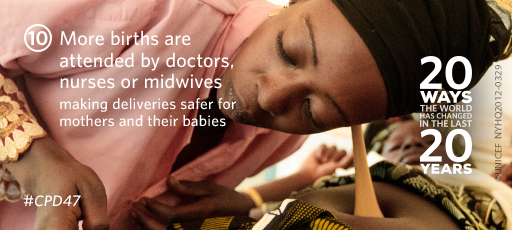
10. The number of births occurring under the care of a skilled attendant – a doctor, midwife or nurse – has grown.
The proportion of deliveries attended by skilled health personnel rose in developing countries, from 56 per cent in 1990 to 67 per cent in 2011. Skilled birth attendance is one of the most critical ways to ensure safe delivery for both mother and child. That, along with increased access to antenatal care, emergency obstetric care and family planning services, accounts for much of the decline in maternal deaths.1,6,7
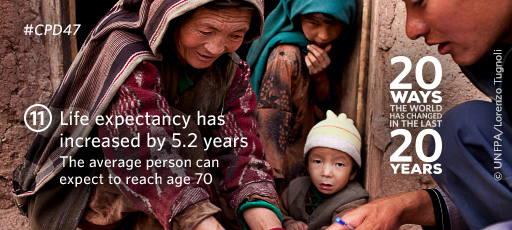
11. Around the world, life expectancy has increased by 5.2 years.
Life expectancy grew from 64.8 years in 1990-1995 to 70 years in 2010-2015. The greatest increases were in the least developed countries, where life expectancy rose by 8.9 years.
Still, too many women continue to die early – often from causes related to pregnancy or extreme poverty – a result of their lower status throughout the world.1,3
12. Fewer abortions are taking place.
Globally, abortion rates have declined, from 35 per 1,000 women in 1995 to 29 per 1,000 women in 2008. This brought the total number of abortions down, despite increased population size.
But improving access to sexual and reproductive health services, including voluntary family planning, would bring these numbers down even further. Addressing unmet family planning needs would avert 54 million unintended pregnancies and result in 26 million fewer abortions.1,5,9
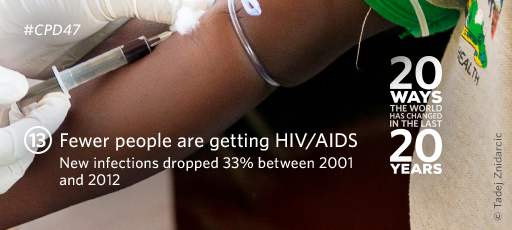
13. The number of people contracting HIV/AIDS has dropped sharply.
New HIV infections fell 33 per cent between 2001 and 2012. Despite this progress, more can still be done to prevent the spread of this illness, especially among youth. In 2009, 41 per cent of new HIV infections were among young people aged 15 to 24. Age-appropriate comprehensive sexuality education helps youth protect themselves against sexually transmitted infections, including HIV.1,9,10
14. But there has been a significant increase in major curable sexually transmitted infections.
Incidence of the four major curable sexually transmitted infections – syphilis, gonorrhoea, chlamydia and trichomoniasis – has spiked among people aged 15 to 49, from 333 million cases in 1995 in 499 million cases in 2008. This development underscores the importance of equipping young people with the sexual and reproductive health knowledge and services required to keep themselves healthy.1,9
15. More people are dying of non-communicable diseases.
Deaths from non-communicable diseases, such as heart disease, cancers, diabetes and chronic respiratory diseases, rose by 30 per cent between 1990 and 2010. Most of these diseases are strongly associated with four harmful behaviours that often begin in adolescence: smoking, alcohol abuse, inactivity and poor nutrition.
Adolescents must be given the tools to protect themselves from these and other harms. Lifelong health education should begin with young people, in concert with comprehensive sexuality education.1,9
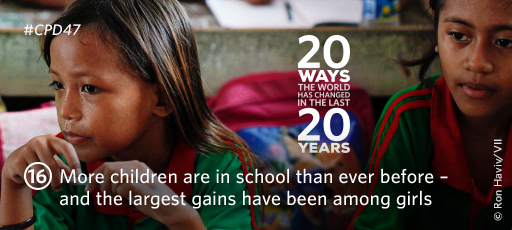
16. More children are attending school than ever – and the largest gains have been among girls.
Primary school enrolment rates have jumped from somewhere over three quarters in 1990 to about 90 per cent in 2010. This is an especially huge victory for girls, who have gained parity in primary school enrolment in a majority of countries. Girls with access to education are better able to avoid adolescent pregnancy and better able to access health care and livelihood opportunities. They and their future families are healthier and more likely to exit poverty.
But gender inequalities in education persist, with girls lagging behind boys in secondary school enrolment.1,11,12,13,14
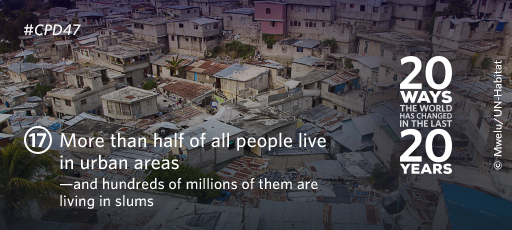
17. The world is increasingly urban.
The global urban population rose by 1.6 billion between 1994 and 2014. More than half the world’s people now live in towns or cities.
But too much of this growth is taking place in slums. Over 650 million people lived in slums in 1990. In 2010, that number was 820 million. Impoverished urban women and girls are especially vulnerable: they are less likely to have access to reproductive health services, education and security.1,3,14
18. More people are migrating than ever before.
There are more international migrants than ever. In 1990, 154 million people travelled from their home countries in search of new opportunities. In 2013, this number was 232 million.
Migration offers important opportunities and helps drive development. But it can also leave migrants – especially women and girls – exposed to abuses, such as trafficking, exploitation and discrimination.1,3,14
19. The world is getting older.
Older people – those over age 60 – are the world’s fastest-growing age group. The number of older persons increased from 490 million in 1990 to 765 million in 2010.
The world must do more to accommodate the needs of this group, including through social protections and systems that ensure their safety and meaningful participation in society.1,3
20. Record numbers of people are displaced within their countries by conflict or violence, taking a disproportionate toll on women and girls.
Gender-based violence is often exacerbated by conflict and displacement; protections are stripped away and sexual violence is used as a tactic of warfare. Twenty years ago, the world saw record numbers of people displaced within their countries’ borders by armed conflict. But today’s numbers are even higher: by 2012, 28.8 million people were internally displaced due to conflict, violence or human rights violations. Additionally, an estimated 15.4 million people were forced to flee their countries as refugees.1,14
Much more work to be done
And there are many more ways in which the world has not changed enough.
Female genital mutilation/cutting (FGM/C) and child marriage remain prevalent in much of the world, even in countries where these practices have been outlawed. Each year, 3 million girls, the majority under age 15, are at risk of undergoing FGM/C. And if current trends continue, by 2020, an additional 142 million girls will be married before age 18.
Gender-based violence continues to be a global epidemic. An estimated one in three women report experiencing physical or sexual abuse, most commonly by an intimate partner. And in a recent survey of 10,000 men in Asia and the Pacific, one in four reported committing rape.
Discrimination against women continues in every community in the world, and belief in gender equality is not yet universal. Women are still denied equal access to opportunities and the ability to define the direction of their lives.
This week, the United Nations Commission on Population and Development will hold its 47th session to address many of these issues, reviewing the progress made and the significant work that remains to be done. As the last 20 years have made clear, human rights – including women’s and girls' rights – must be placed at the heart of global development.
– Rebecca Zerzan
1. Framework of actions for the follow-up to the Programme of Action of the International Conference on Population and Development beyond 2014, Report of the Secretary-General, distributed 12 February 2014, A/69/62
2. ICPD Factsheet on Sustainability , February 2014
3. World Demographic Trends, Report of the Secretary-General, 21 January 2014, E/CN.9/2014/3
4. UNFPA, State of the World Population: Mother in Childhood, Facing the Challenge of Adolescent Pregnancy , 2013
5. Singh S and Darroch JE, Adding It Up: Costs and Benefits of Contraceptive Services—Estimates for 2012 , New York: Guttmacher Institute and United Nations Population Fund (UNFPA), 2012
6. ICPD Global Review Report Press Release
7. ICPD Beyond 2014 – Framework of Actions, Briefing on the findings of the ICPD Beyond 2014 Review, PowerPoint presentation
8. A Promise Renewed , UNICEF, September 2013
9. ICPD Factsheet on Health , February 2014
10. Report on the Global AIDS Epidemic , UNAIDS, 2013
11. ICPD Factsheet on Dignity and Human Rights , February 2014
12. State of the World’s Children Report , UNICEF, 1994
13. State of the World’s Children Report , UNICEF, 2014
14. ICPD Factsheet on Place and Mobility , February 2014